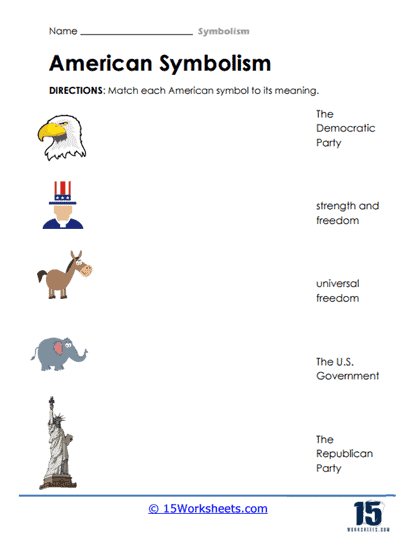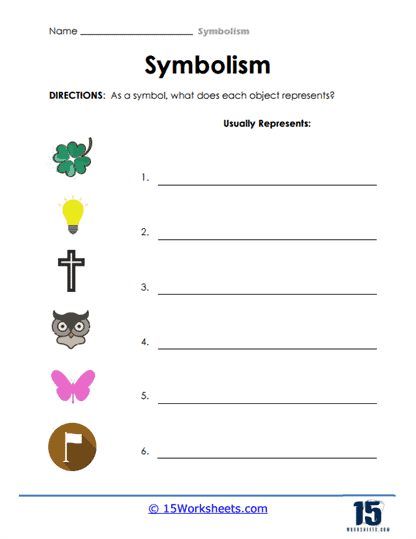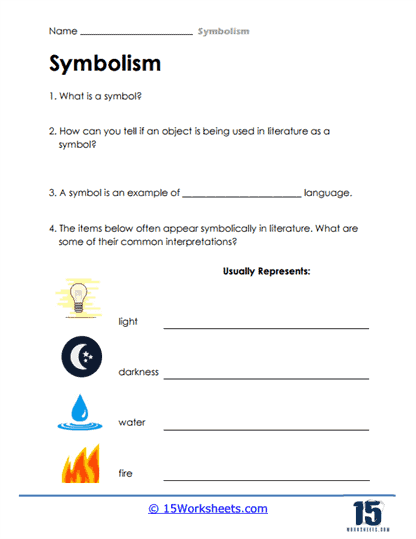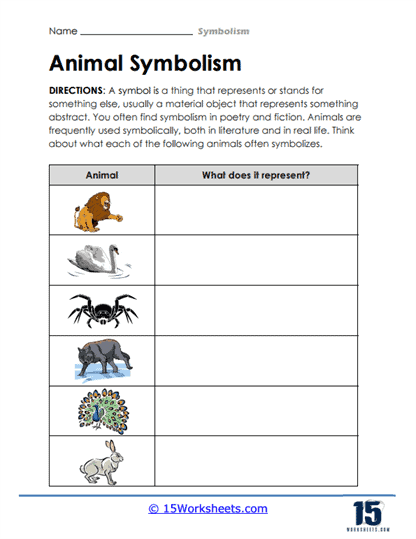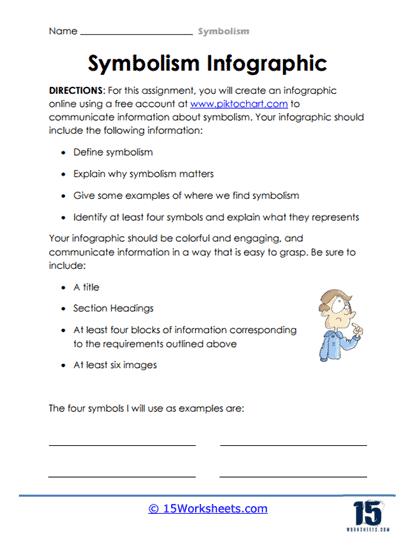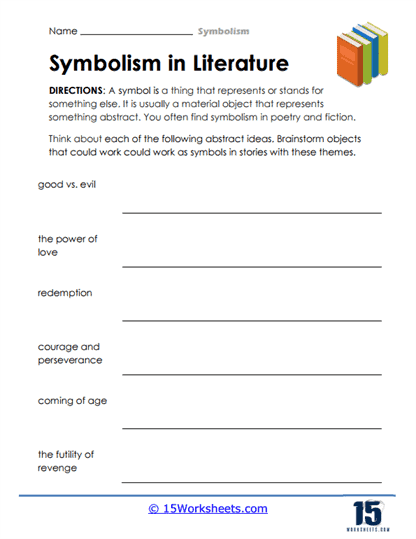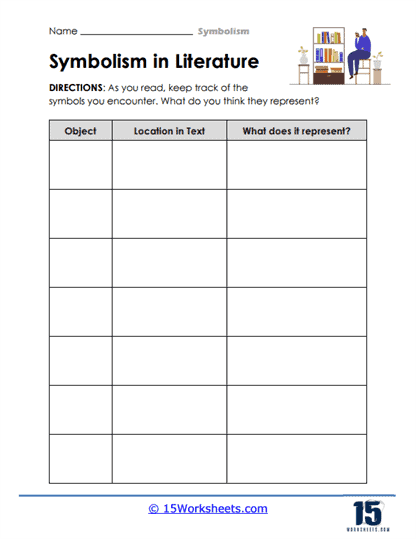Symbolism Worksheets
About These 15 Worksheets
These worksheets help you understand and practice identifying symbols in literature or visual representations. Symbolism is the use of symbols to represent ideas, qualities, or concepts beyond their literal meaning. Symbols are objects, images, or actions that have a deeper, often metaphorical significance.
To explain symbolism, let’s look at an example – Imagine a story where a character releases a caged bird into the sky. In this story, the bird could symbolize freedom, hope, or a new beginning. By releasing the bird, the author uses it as a symbol to convey a deeper meaning or message about the character’s emotions or the overall theme of the story.
Symbolism worksheets provide exercises and activities that help you recognize, identify, and interpret symbols in literature or visual representations. These worksheets often contain examples of symbols, and you have to analyze their meanings or find symbols in given passages or images.
By working on symbolism worksheets, you can:
Identify Symbols – Symbolism worksheets help you develop the skill of recognizing symbols in literature or visual representations. By reading passages or examining images, you learn to identify objects, images, or actions that represent or stand for something beyond their literal meaning. This skill allows you to appreciate the layers of meaning and the use of symbolism in creative works.
Interpret Symbolic Meaning – Symbolism worksheets allow you to explore the deeper meanings behind symbols. You learn to analyze the context, themes, and characters to understand the symbolic significance of objects or actions. By interpreting symbols, you gain insight into the author’s intention and the broader messages or themes conveyed in the work.
Enhance Critical Thinking – Working on symbolism worksheets fosters critical thinking skills. Symbolism encourages you to look beyond the surface level of a text or image and consider the underlying meanings and connections. It prompts you to analyze and interpret the symbolic language used by the author or artist, encouraging a deeper understanding and engagement with the work.
Appreciate Metaphorical Language – Symbolism helps you appreciate the power of metaphorical language. Symbols add depth and complexity to a story or artwork by conveying abstract ideas or emotions through concrete representations. By exploring symbolism, you develop a deeper understanding and appreciation for the artistry and creativity in expressing meaning through metaphor.
Connect with Themes and Messages – Symbols connect readers or viewers with the themes and messages conveyed in the work. By representing larger ideas or concepts, symbols enable a deeper emotional or intellectual connection. Symbols help convey universal human experiences or concepts, fostering empathy and understanding.
Why Do Authors Use Symbolism In Their Work?
Authors use symbolism in their work for several reasons:
Enhancing Depth and Meaning – Symbolism adds depth and layers of meaning to the text. By using symbols, authors can convey abstract ideas, emotions, or concepts in a more evocative and powerful way. Symbols allow authors to communicate complex or universal themes that may be difficult to express directly.
Invoking Emotions and Imagination – Symbols have the power to evoke emotions and engage the reader’s imagination. They can elicit a strong emotional response or create a sense of intrigue, mystery, or wonder. Symbols tap into the reader’s subconscious and invite them to make personal connections and interpretations, enhancing the overall reading experience.
Creating Visual and Sensory Imagery – Symbols create visual and sensory imagery that helps readers visualize and experience the text. By using objects, images, or actions as symbols, authors can paint vivid mental pictures or engage readers’ senses. Symbols make the writing more memorable and immersive, allowing readers to connect with the story on a deeper level.
Conveying Universal Themes and Ideas – Symbols have the ability to transcend cultural, geographical, and temporal boundaries. They can convey universal themes, ideas, or human experiences that resonate with readers across different backgrounds. Symbols enable authors to communicate messages that are relevant and meaningful to a wide range of readers.
Encouraging Interpretation and Engagement – Symbolism encourages readers to actively engage with the text and participate in its interpretation. Symbols invite readers to analyze, question, and seek deeper meanings. They stimulate critical thinking and encourage readers to explore the connections between symbols and the larger context of the work.
Adding Layers of Subtext – Symbols can be used to convey subtext or hidden meanings beneath the surface of the narrative. They can represent underlying themes, character motivations, or social or political commentary. Symbols allow authors to communicate ideas in a subtle and nuanced manner, inviting readers to explore the underlying layers of the story.
Creating Unity and Coherence – Symbols can be used to unify and provide coherence to a work of literature. They can serve as recurring motifs that tie different elements of the story together, creating a sense of unity and reinforcing thematic or narrative threads. Symbols help structure and organize the narrative, enhancing its overall impact.







